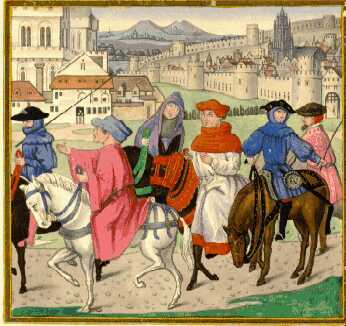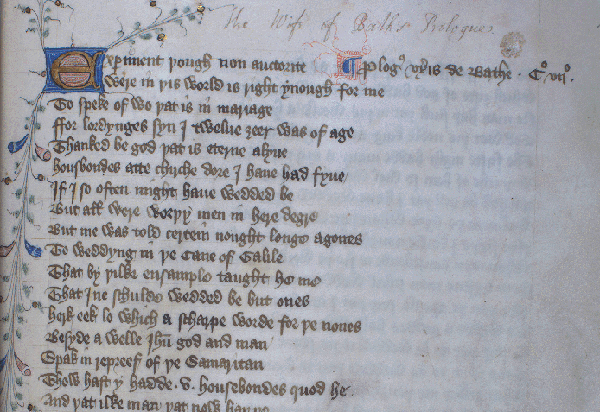
"The Wife Of Bath"
What is the meaning of marriage? Does it mean loyalty,
honesty and love, or does it mean money, sovereignty and
the pleasure of sex? Alisoun, the Wife of Bath, as described
in Geoffrey Chaucer's "General Prologue" of the Canterbury Tales
and in the "Wife of Bath's Prologue," defines marriage both ways.
As a woman living in the fourteenth century, she has
a very modern view of marriage even women in the twentieth
century do not have. Alisoun has been married five times
and is now looking for a sixth husband. She is proud of her
marriage experience and believes the more she marries the
better she is.

In the "General Prologue," Chaucer describes Alisoun
as a cloth maker who surpasses the weavers of the Low Countries.
She shows off her skills by wearing layers of cloth she has made herself.
She has big hips and a gap-tooth (which she says symbolizes
sensuality and lust). The Wife of Bath is certainly a
woman who likes to catch attention by wearing the color
red. She is described this way in the "General Prologue":
"Hir hosen (leggings) weren of fin scarlet reed (red),
Ful straite yteyd (tightly laced), and shoes ful moiste
(supple) and newe. Bold was hir face and fair and reed
of hewe." (Norton 92). Later, she talks about her
red dresses.
Money is an important issue in her marriages. Out of
the five husbands that Alisoun has had, she considers three
of them good because they are old and rich: "Tho housbonds
that I hadde, As three of hem were goode, and two were
badde. The three men were goode, and riche, and olde" (Norton 121).
The three husbands are good because they die eventually,
and she takes care of herself with the money they leave for
her. Her fourth and fifth husbands are bad because they
are young and wild. Her fourth husband has a mistress,
and she revenges herself on him by pretending to fall in
love with someone else.
Alisoun has sovereignty over her husbands.
Since she is so experienced with men, she knows what men
need most. In her "Prologue," she points out how she
controls four of her husbands: "I governed hem so wel after
(according to) my lawe" (Norton 122). However,
she doesn't have this power over her fifth husband, Janekin,
who shows interest in a book about "Wicked Wives" more than
in her. When Janekin is reading his book about wicked
wives, Alisoun gets upset: "Al sodeinly three
leves have I plight (snatched) Out of his book right as
he redde, and eke I with my fist so took (hit) him on
the cheeke That in oure fir he fil (fell) bakward adown."
(Norton 134). After she tears the pages out of his
book, Janekin hits her on the head, which is why she is
deaf in one ear. Afterward, he is sorry and burns his
book. He also gives her the house and lands that also
gives her sovereignty over him.

The Wife of Bath, as she says in her "Prologue,"
focuses her marriages on the pleasures she gets through
sex. She is proud of her sexual experience. She says,
"Of whiche I have piked out the beste, Bothe of hir
nether (lower) purs and of hir cheste (money box)"
(Norton 118). This means that she married men
for their sex organs and their money. She describes her
husband this way: "An housbonde wol I have, I wol nat lette,
which shal be bothe my dettour (debtor) and my thral (slave),
and have his tribulacion withal upon his flessh whil
that I am his wif" (Norton 120). In other words,
her husband is her debtor and slave. The way he pays for
his debt is by making love to her.
As a woman at the end of the twentieth century, I
still cannot accept the behavior of the Wife of Bath as discussed in
her "Prologue". Her views on marriage and the ways that she treats her
husbands are certainly not how a woman should act in that
period of time or now. I feel that there should be
tolerance and equality in a marriage because that is the only
way that marriage can last forever. Unlike her "Prologue,"
the Wife of Bath's "Tale" is about a knight and a hag. The hag is married
to the knight and when she asks him to choose her of being old, ugly and
faithful or young, beautiful, and unfaithful. He tells her to choose, which gives
her the sovereignty. The hag then turns into a beautiful woman, and they live
happily ever after. From her "Tale," we can see that there is happiness in a marriage
if both parts are considerate of each other. However, the Wife of Bath does
not act this way toward her husbands.



